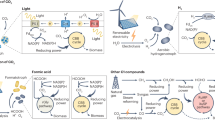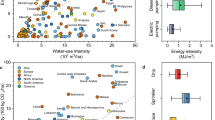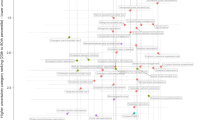Abstract
The distance between the origin and end-point of food supply chains, and the ‘localness’ of food systems, are key considerations of many narratives associated with sustainability. Yet, information on the minimum distance to food crops is still scarce at the global level. Using an optimization model based on ‘foodsheds’ (that is, self-sufficient areas with internal dependencies), we calculate the potential minimum distance between food production and consumption for six crop types around the world. We show that only 11–28% of the global population can fulfil their demand for specific crops within a 100-km radius, with substantial variation between different regions and crops. For 26–64% of the population, that distance is greater than 1,000 km. Even if transnational foodsheds were in place, large parts of the globe would still depend on trade to feed themselves. Although yield gap closure and food loss reductions could favour more local food systems, particularly in Africa and Asia, global supply chains would still be needed to ensure an adequate and stable food supply.
This is a preview of subscription content, access via your institution
Access options
Access Nature and 54 other Nature Portfolio journals
Get Nature+, our best-value online-access subscription
$29.99 / 30 days
cancel any time
Subscribe to this journal
Receive 12 digital issues and online access to articles
$119.00 per year
only $9.92 per issue
Buy this article
- Purchase on Springer Link
- Instant access to full article PDF
Prices may be subject to local taxes which are calculated during checkout






Similar content being viewed by others
Data availability
Key outcome data is available at https://doi.org/10.5281/zenodo.3725646.
Code availability
All scripts for the optimization and calculations of the minimum achievable distance are available from the corresponding authors.
References
D’Odorico, P., Carr, J. A., Laio, F., Ridolfi, L. & Vandoni, S. Feeding humanity through global food trade. Earth Future 2, 458–469 (2014).
Porkka, M., Kummu, M., Siebert, S. & Varis, O. From food insufficiency towards trade dependency: a historical analysis of global food availability. PLoS ONE 8, e82714 (2013).
Porkka, M., Guillaume, J. H. A., Siebert, S., Schaphoff, S. & Kummu, M. The use of food imports to overcome local limits to growth. Earth Future 5, 393–407 (2017).
Liu, W. et al. Savings and losses of global water resources in food‐related virtual water trade. WIREs Water 6, e1320 (2019).
Kearney, J. Food consumption trends and drivers. Phil. Trans. R. Soc. B 365, 2793–2807 (2010).
Seekell, D. et al. Resilience in the global food system. Environ. Res. Lett. 12, 025010 (2017).
Suweis, S., Carr, J. A., Maritan, A., Rinaldo, A. & D’Odorico, P. Resilience and reactivity of global food security. Proc. Natl Acad. Sci. USA 112, 6902–6907 (2015).
Cottrell, R. S. et al. Food production shocks across land and sea. Nat. Sustain. 2, 130–137 (2019).
Morgan, K., Marsden, T. & Murdoch, J. Worlds of Food: Place, Power, and Provenance in the Food Chain (Oxford Univ. Press, 2006).
Hinrichs, C. C. The practice and politics of food system localization. J. Rural Stud. 19, 33–45 (2003).
DuPuis, E. M. & Goodman, D. Should we go “home” to eat?: toward a reflexive politics of localism. J. Rural Stud. 21, 359–371 (2005).
Chaifetz, A. & Jagger, P. 40 years of dialogue on food sovereignty: a review and a look ahead. Glob. Food Secur. 3, 85–91 (2014).
Burnett, K. & Murphy, S. What place for international trade in food sovereignty? J. Peasant Stud. 41, 1065–1084 (2014).
Weber, C. L. & Matthews, H. S. Food-miles and the relative climate impacts of food choices in the United States. Environ. Sci. Technol. 42, 3508–3513 (2008).
Hertel, T. W., Ramankutty, N. & Baldos, U. L. C. Global market integration increases likelihood that a future African Green Revolution could increase crop land use and CO2 emissions. Proc. Natl Acad. Sci. USA 111, 13799–13804 (2014).
Pradhan, P., Lüdeke, M. K. B., Reusser, D. E. & Kropp, J. P. Food self-sufficiency across scales: how local can we go? Environ. Sci. Technol. 48, 9463–9470 (2014).
Fader, M., Gerten, D., Krause, M., Lucht, W. & Cramer, W. Spatial decoupling of agricultural production and consumption: quantifying dependences of countries on food imports due to domestic land and water constraints. Environ. Res. Lett. 8, 014046 (2013).
Horst, M. & Gaolach, B. The potential of local food systems in North America: a review of foodshed analyses. Renew. Agric. Food Syst. 30, 399–407 (2015).
Coley, D., Howard, M. & Winter, M. Local food, food miles and carbon emissions: a comparison of farm shop and mass distribution approaches. Food Policy. 34, 150–155 (2009).
Kreidenweis, U., Lautenbach, S. & Koellner, T. Regional or global? The question of low-emission food sourcing addressed with spatial optimization modelling. Environ. Model. Softw. 82, 128–141 (2016).
Kriewald, S., Pradhan, P., Costa, L., Ros, A. G. C. & Kropp, J. P. Hungry cities: how local food self-sufficiency relates to climate change, diets, and urbanisation. Environ. Res. Lett. 14, 094007 (2019).
Peters, C. J., Bills, N. L., Wilkins, J. L. & Fick, G. W. Foodshed analysis and its relevance to sustainability. Renew. Agric. Food Syst. 24, 1–7 (2009).
Verburg, P. H., Ellis, E. C. & Letourneau, A. A global assessment of market accessibility and market influence for global environmental change studies. Environ. Res. Lett. 6, 034019 (2011).
Porteous, O. High trade costs and their consequences: an estimated dynamic model of african agricultural storage and trade. Am. Econ. J. Appl. Econ. 11, 327–366 (2019).
Chabot, P. & Dorosh, P. A. Wheat markets, food aid and food security in Afghanistan. Food Policy 32, 334–353 (2007).
Boulanger, P., Dudu, H., Ferrari, E., Himics, M. & M’Barek, R. Cumulative Economic Impact of Future Trade Agreements on EU Agriculture (JRC, European Commission, 2016); https://doi.org/10.2788/194880
Mbow, C. et al. in Climate Change and Land: An IPCC Special Report on Climate Change, Desertification, Land Degradation, Sustainable Land Management, Food Security, and Greenhouse Gas Fluxes in Terrestrial Ecosystems (eds Shukla, P. R. et al.) Ch. 5 (IPCC, in the press); https://www.ipcc.ch/site/assets/uploads/sites/4/2019/11/08_Chapter-5.pdf
Foley, J. A. et al. Solutions for a cultivated planet. Nature 478, 337–342 (2011).
Puma, M. J. et al. A developing food crisis and potential refugee movements. Nat. Sustain. 1, 380–382 (2018).
Gornall, J. et al. Implications of climate change for agricultural productivity in the early twenty-first century. Phil. Trans. R. Soc. B 365, 2973–2989 (2010).
Laroche Dupraz, C. & Postolle, A. Food sovereignty and agricultural trade policy commitments: how much leeway do West African nations have? Food Policy 38, 115–125 (2013).
Marchand, P. et al. Reserves and trade jointly determine exposure to food supply shocks. Environ. Res. Lett. 11, 095009 (2016).
Wood, S. A., Smith, M. R., Fanzo, J., Remans, R. & DeFries, R. S. Trade and the equitability of global food nutrient distribution. Nat. Sustain. 1, 34–37 (2018).
Kummu, M. et al. Bringing it all together: linking measures to secure nations’ food supply. Curr. Opin. Environ. Sustain. 29, 98–117 (2017).
Springmann, M. et al. Options for keeping the food system within environmental limits. Nature 562, 519–525 (2018).
Gerten, D. et al. Feeding ten billion people is possible within four terrestrial planetary boundaries. Nat. Sustain. 3, 200–208 (2020).
FAO Food Balance Sheets (FAO, 2018).
MacDonald, G. K. et al. Rethinking agricultural trade relationships in an era of globalization. BioScience 65, 275–289 (2015).
Portugal-Perez, A. & Wilson, J. S. Export performance and trade facilitation reform: hard and soft infrastructure. World Dev. 40, 1295–1307 (2012).
Kummu, M. et al. Lost food, wasted resources: global food supply chain losses and their impacts on freshwater, cropland, and fertiliser use. Sci. Total Environ. 438, 477–489 (2012).
Wellesley, L., Preston, F., Lehne, J. & Bailey, R. Chokepoints in global food trade: assessing the risk. Res. Transp. Bus. Manag. 25, 15–28 (2017).
Alemu, R., Block, S. A., Headey, D. D., Bai, Y. & Masters, W. A. Where are nutritious diets most expensive? Evidence from 195 foods in 164 countries. In Allied Social Science Associations (ASSA) Annual Meeting https://go.nature.com/2Umkkzc (ASSA, 2019).
Born, B. & Purcell, M. Avoiding the local trap: scale and food systems in planning research. J. Plan. Educ. Res. 26, 195–207 (2006).
Ericksen, P. J. Conceptualizing food systems for global environmental change research. Glob. Environ. Change 18, 234–245 (2008).
Bondeau, A. et al. Modelling the role of agriculture for the 20th century global terrestrial carbon balance. Glob. Change Biol. 13, 679–706 (2007).
Heino, M. et al. Two-thirds of global cropland area impacted by climate oscillations. Nat. Commun. 9, 1257 (2018).
Gustavsson, J., Cederberg, C. & Sonesson, U. Global Food Losses and Food Waste: Extent, Causes and Prevention (FAO, 2011).
Cassidy, E. S., West, P. C., Gerber, J. S. & Foley, J. A. Redefining agricultural yields: from tonnes to people nourished per hectare. Environ. Res. Lett. 8, 034015 (2013).
Klein Goldewijk, K., Beusen, A., Doelman, J. & Stehfest, E. Anthropogenic land use estimates for the Holocene—HYDE 3.2. Earth Syst. Sci. Data. 9, 927–953 (2017).
Puma, M. J. The Global Food Commodity Database v1.0. (Columbia Univ., 2018).
Francis, R. L., Lowe, T. J., Rayco, M. B. & Tamir, A. Aggregation error for location models: survey and analysis. Ann. Oper. Res. 167, 171–208 (2009).
MATLAB v.9.5.0.944444 (MathWorks Inc., 2018).
Global Shipping Lane Network World, 2000 (CTA Transportation Network Group, Oak Ridge National Labs, 2000).
Vector Map Level 0 (VMAP0) (National Imagery and Mapping Agency, 1997).
Meijer, J. R., Huijbregts, M. A. J., Schotten, K. C. G. J. & Schipper, A. M. Global patterns of current and future road infrastructure. Environ. Res. Lett. 13, 064006 (2018).
Weiss, D. J. et al. A global map of travel time to cities to assess inequalities in accessibility in 2015. Nature 553, 333–336 (2018).
Rodrigue, J.-P., Comtois, C. & Slack, B. The Geography of Transport Systems (Routledge, 2013).
Verlegh, P. W. J. Home country bias in product evaluation: the complementary roles of economic and socio-psychological motives. J. Int. Bus. Stud. 38, 361–373 (2007).
Hijmans, R. J. raster: Geographic data analysis and modeling. R package version 3.0-7 (2019).
Acknowledgements
The authors thank their colleagues from the Water and Development research group for their comments and support. P.K. and M.T. received funding from Maa- ja vesitekniikan tuki ry. through its Majakka project. M.J.P. was supported in whole or in part by the Army Research Office/Army Research Laboratory under award no. W911NF1810267 (Multi-University Research Initiative). The views and conclusions contained in this document are those of the authors and should not be interpreted as representing the official policies either expressed or implied of the Army Research Office or the US Government. M.J. received funding from Maa- ja vesitekniikan tuki ry. M.K. received financial support from the Academy of Finland project WASCO (grant no. 305471), the Academy of Finland SRC project ‘Winland’, the Emil Aaltonen foundation project ‘eat-less-water’ and the European Research Council (ERC) under the European Union’s Horizon 2020 research and innovation programme (grant agreement no. 819202). J.H.A.G. received support from WASCO and ‘eat-less-water’. P.D. was funded by the USDA Hatch Multistate project no. W4190 capacity fund.
Author information
Authors and Affiliations
Contributions
M.K., P.K. and J.H.A.G. conceptualized the study. P.K. and J.H.A.G coded the numerical analyses. P.K., J.H.A.G., M.T. and M.K. analysed the data and made the visualizations in consultation with P.D., S.S., M.J.P. and M.J. P.K. drafted the manuscript. P.K., J.H.A.G., M.T., P.D., S.S., M.J.P. and M.K. wrote and edited the paper.
Corresponding authors
Ethics declarations
Competing interests
The authors declare no competing interests.
Additional information
Publisher’s note Springer Nature remains neutral with regard to jurisdictional claims in published maps and institutional affiliations.
Supplementary information
Supplementary Information
Supplementary Note 1, mathematical notation and Figs. 1–12.
Rights and permissions
About this article
Cite this article
Kinnunen, P., Guillaume, J.H.A., Taka, M. et al. Local food crop production can fulfil demand for less than one-third of the population. Nat Food 1, 229–237 (2020). https://doi.org/10.1038/s43016-020-0060-7
Received:
Accepted:
Published:
Issue Date:
DOI: https://doi.org/10.1038/s43016-020-0060-7
This article is cited by
-
Health burden from food systems is highly unequal across income groups
Nature Food (2024)
-
Mapping lock-ins and enabling environments for agri-food sustainability transitions in Europe
Sustainability Science (2024)
-
Increased food-miles and transport emissions
Nature Food (2023)
-
Mapping the consumer foodshed of the Kampala city region shows the importance of urban agriculture
npj Urban Sustainability (2023)
-
Reframing the local–global food systems debate through a resilience lens
Nature Food (2023)



